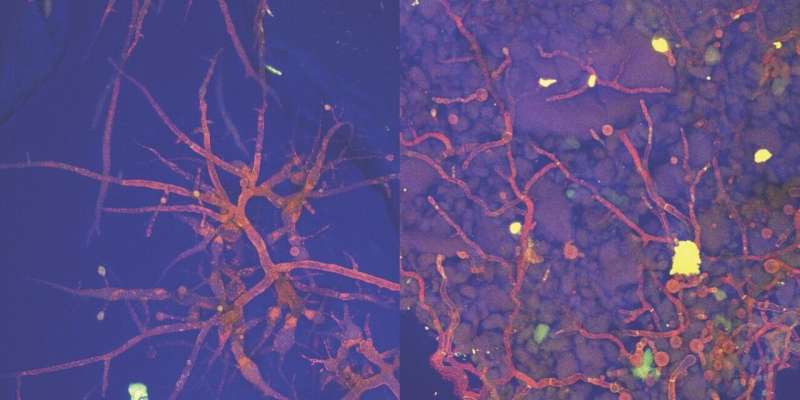Fungal filaments (false-coloured pink) grown in liquid (left) or transparent soil (right). Credit: Sharma et al. (CC BY 4.0)
By using two different transparent soil substitutes, scientists have shown that soil bacteria rely on fungi to help them survive dry periods, says a study published today ineLife.
The findings indicate that these soil-like substrates may enable researchers to observe the complex interactions of the myriad microscopic creatures that live in soil. This ability is crucial to help us better understand the role that soil and soil microbes play in healthy ecosystems.
Millions of microscopic organisms such as fungi and bacteria live in the soil. They are essential for healthy ecosystems because they support the growth of plants and capture and store carbon from the atmosphere. But studying these processes in real soil can be challenging.
"To advance the study of soil processes, we used transparent soil substitutes that allowed us to use microscopes and other experimental techniques to see and measure the activity of soil bacteria and determine how this activity depends on the fungi," says lead author Kriti Sharma, who completed the study as a doctoral student at the University of North Carolina at Chapel Hill, US, and is now a postdoctoral scholar at Caltech, Pasadena, US.
In the experiments, Sharma and collaborators from Vienna, Austria, successfully grew soil bacteria and fungi in two transparent soil substitutes. One was a synthetic substance called Nafion and the other was a naturally occurring crystal called cryolite. They also demonstrated that it was possible to observe living microbes in these substitutes using a microscope and to measure the organisms' overall metabolic activity and uptake of carbon using a technique called Raman microspectroscopy.
Next, they used the soil substitutes to study what happens to bacteria when soil goes from being dried out to wet again. The experiments showed that while many soil bacteria die or become inactive when soil dries out, bacteria living near dead fungi remain active and use the fungi as a source for carbon. "In this way, fungi promote the activity of soil bacteria in changing environmental conditions," Sharma says.
The transparent soil systems reported in the study will likely be used by many other researchers who study soil ecology, adds senior author Elizabeth Shank, Associate Professor in the Program in Systems Biology and Department of Microbiology and Physiological Systems at the University of Massachusetts Medical School, Worcester, Massachusetts, US.
"For example, they could be used to explore how interactions between bacteria, fungi, and other microscopic creatures living in soil help support the growth of crops," she says. "Or to better understand how carbon is stored and released from soil, which may be critical to combating climate change. Overall, these transparent soil substitutes are powerful tools that will help us answer many outstanding questions in soil microbial ecology."
More information: Kriti Sharma et al, Transparent soil microcosms for live-cell imaging and non-destructive stable isotope probing of soil microorganisms, eLife (2020). DOI: 10.7554/eLife.56275
Journal information: eLife
Provided by eLife
























